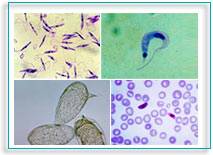
The principal objectives of the project are:

- The identification of HMEs from Leishmania sp. and Trypanosoma cruzi and the molecular characterization and functional characterization of selected potential targets. In the case of T. cruzi a gene knockout strategy will be used to validate HMEs as therapeutic targets.
- Phenotypic screening of Leishmania, T. cruzi, S. mansoni and P. falciparum using HME class inhibitors and inhibitors developed specifically against S. mansoni and P. falciparum HMEs. This will permit us to obtain a comprehensive view of inhibitor classes and chemical scaffolds of interest. It is anticipated that compounds developed against a particular parasite HME may prove useful lead compounds for development against other parasites, hence validating target and inhibitor in one step.
- Production of recombinant Leishmania, S. mansoni, P. falciparum and T. cruzi HME proteins, structural studies. Selected, validated target enzymes will be produced, crystallized and analysed by X-ray diffraction. Assays will be optimized for rapid screening of inhibitors.
- High-throughput and structure-based screening of selected HMEs. Validated hits from HTS and experimentally verified hits from in silico docking will be further screened in phenotypic assays on the parasites in vitro.
- Optimisation of inhibitor structures by chemical synthesis based on molecular modelling studies (inhibitors of all origins). Bioguided feedback will allow optimization of potency and selectivity.
- Transcriptomic analysis of drug-treated parasites to verify target specificity and mechanism of action (all parasites). This will allow a deeper understanding of downstream events that will allow us to select potential targets/drugs for future combination studies.
- Pharmacological and toxicological studies (in vitro and in vivo) of selected inhibitors, in vivo testing of compounds in parasite-infected mice. Promising inhibitors will be optimized in terms of pharmacokinetics to lead to advanced candidates
| To accomplish this work, the project participants have been selected for their capacity to provide the required high level expertise (see work plan). We have also incorporated several key state-of-the-art platforms (high throughput screening, in silico screening, recombinant protein production and structure determination, phenotypic testing, toxicology and pharmacology and high throughput sequencing), that will ensure that the proposed goals can be realized. |